It can be difficult to grasp the scale of Edward Burtynsky’s subjects when there are no points of reference — no recognizable objects, intentionally no humans, and sometimes no horizon. Your understanding of what you’re looking at changes between close proximity and several steps back. Sometimes it’s better just to wonder, because comprehending the vast scale of a field of oil drilling rigs, Alberta’s oil sands or a coal mine in BC can take the wind out of you — at least, if you’re as affected as I am by these visuals. I left feeling pretty drained as it’s emotionally taxing to look at how we’ve shaped, polluted and destroyed the landscape of our planet to meet ever-growing needs. Not everything in the Vancouver Art Gallery’s exhibit of Burtynsky’s work was dark, but a bleak image of a massive pile of tires (at a distance, just a huge wave of black) burning after a lightning strike had me reeling and thinking, “what have we done?”
“In Burtynsky’s vernacular, the ‘manufactured landscape’ is no longer a simple contest of nature versus culture; instead his images suggest an emergent condition in which the natural world has been fully consumed, never to reappear again.” — Vancouver Art Gallery
I was standing in front of a large format aerial photograph of a Scottsdale, Arizona suburb when the woman next to me said, “this is the scariest one.” I don’t know if she’d been to the other side of the exhibit yet, but I understood what she meant. A rectangle of desert with a road around its perimeter marks the Navajo reserve, abruptly divided from suburbia, which is the usual unsustainable pattern: tendrils of cul-de-sacs, single-family houses — many with pools — tennis courts, and trees, all supported by a dwindling water supply. Far, far in the distance one can see a few towers in Phoenix, an unpleasant highway commute away. Now that I have time to absorb it, the connection between this and the rest of the exhibit is clear: the activity documented by Burtynsky feeds this horrific exercise in “community planning.” Artificially cheap oil, mining coal and metals, irrigating the desert — it’s all to feed an insatiable appetite called the American Dream.
I’ve been working for months on various campaigns working to shift away from Canada’s large-scale, rapid energy extraction, consumption and export economy, and toward green energy and jobs. Our opposition is wealthy and determined, and the media not always kind. Exhibitions such as Burtynsky’s, or similarly Chris Jordan (on consumption and waste), help to bring a real-life tangibility to what corporations and consumers are doing. It’s up to us to fight for the alternatives, and to be reminded of the ways in which we can meet reasonable needs responsibly.
To that end, here are a few ways you can get involved:
Sign the pledge to push for a fair, province-wide vote on oil pipelines and tanker traffic in BC
100 in 1 Day, Vancouver edition — multiple workshop dates culminating in 100 urban interventions on June 7th each in Vancouver, Toronto, Montreal and Halifax
CanRoots, May 23–24
10th anniversary screening of The Corporation, May 26th
The Edward Burtynsky exhibition at the Vancouver Art Gallery ends May 26th.
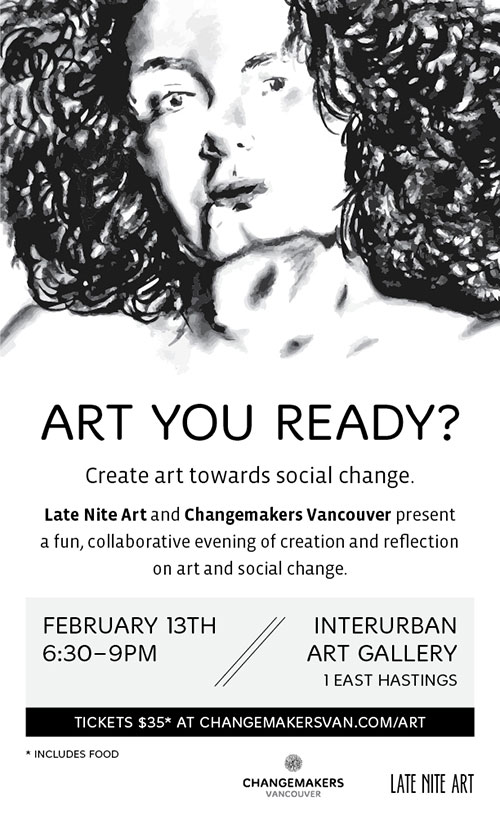
I volunteer my time and design skills to an awesome burgeoning group called Changemakers Vancouver, which is “a network of people who want to learn, share, and act so to make the world a better place.” On February 13th, we’re teaming up with Late Nite Art for an evening around what insights we can gain when we engage our creativity.
Late Nite Art is a facilitated workshop that brings community together to collaboratively explore thought-provoking ideas and issues through visual arts. We achieve this by combining fresh local food, gratuitous beats, and explorative artmaking in one tasty package.
You definitely don’t have to be artistic to participate. In fact, I think the more diverse a crowd we have, the more interesting and fun our evening and outcomes will be!
Really good food is included in your $35 ticket, which you should get today since capacity is limited.
See you there!
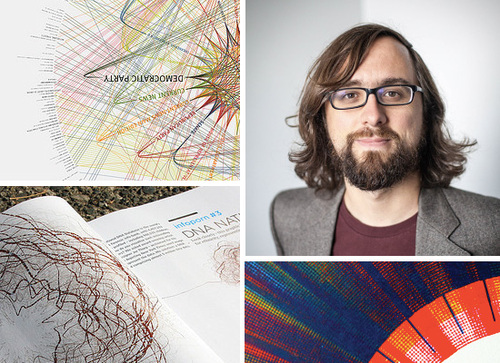
PRACTIVISM 6
Friday, November 29th, 2013
6pm – 10pm at The Ironworks
If you’ve attended any of the previous Practivism speaker events, you probably don’t need convincing to attend this one. Now in its sixth year, the annual event brings change-making creatives from Vancouver and beyond to talk about their projects and the designer’s role in influencing change, whether it be social, environmental or in our practice. This year the keynote speaker is artist and educator Jer Thorp. “Coming from a background in genetics, his digital art practice explores the many-folded boundaries between science, data, art, and culture.”
Our 6th annual Practivism event will explore the opportunities that lay in front of each of us within the vast amount of data we pass by on a daily basis. A panel discussion with Alex Beim, Casey Hrynkow, and Eric Karjaluoto, moderated by Amanda Gibbs will further explore the possibilities and challenge individuals to take action — to envision and mobilize a better future.
The event has grown a lot since its sustainability-focussed beginnings. I’m looking forward to seeing what Thorp offers the event and audience on November 29th.
Get your tickets online now. Practivism sold out last year!
See you there.
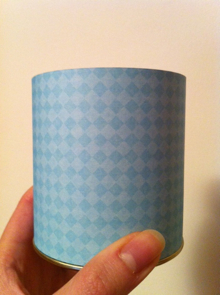
I had a tea container I couldn’t recycle, so I repurposed it with a strip of cute paper.
GOOD Magazine‘s latest contest asked for photographs of something repurposed and today they announced the winner, beautiful lamps made from glass bottles, by Lauren Lee. They’re stunning and blur art and design together, in the sense that she used essentially a readymade and added both intent and function.
Contributor Ivy Lane calls repurposing objects and materials “upcycling”, in stark contrast to downcycling, which typically refers to the deterioration of plastic as it undergoes multiple recycling processes. Repurposing is the ultimate sustainable thing to do with stuff that already exists. It extends its life, creates something new (our brains thrive on novelty, hence the rampant consumer culture), and inspires creative thinking to imagine objects being used for another purpose in new combinations. It’s easy to think of repurposing as taking something easily recyclable and giving it a new lease on life, but where it succeeds most wonderfully is in saving garbage-bound objects from an eternity in a landfill, bringing to mind the old adage, “One person’s trash is another’s treasure.” (Just check out some select submissions to see what I mean.)
I hope repurposing can find a home nestled between the handmade revolution and high design so as to appeal to anyone. In fact, there is no reason it cannot.
 This daily green blog challenge is in celebration of David Suzuki’s 75th birthday, supporting the David Suzuki Foundation. Please help me out by sponsoring me online now.
This daily green blog challenge is in celebration of David Suzuki’s 75th birthday, supporting the David Suzuki Foundation. Please help me out by sponsoring me online now.
Note: I am writing solely on my own behalf, and do not claim to represent the David Suzuki Foundation or its views here.
Oh my goodness! I’m nearly at my $300 fundraising goal as I write this. Please donate now to support the David Suzuki Foundation. Here’s why I’m fundraising with a daily post!
I was excited when I noticed a dramatic, beautiful piece of art hanging over my head on the bus the other morning. It was Emily Carr University student Alison Woodward’s work (see the eighth image here), one of 31 images by 18 artists studying at the school. It’s TransLink’s new pilot initiative, which is “building on the success of the Poetry in Transit program, which seeks to bring visual art into the transit environment through on-vehicle advertising panels featuring emerging artists.” I quite enjoy the Poetry on Transit panels when I find one I like, and so far, in Art on Transit, I love what I’m seeing.
Continue reading Vancouver’s buses get a little arty »
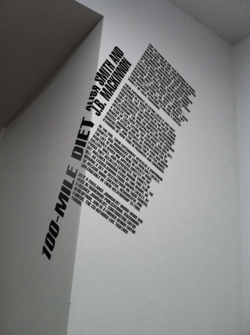
Last week I experienced the WE:Vancouver exhibition at the Vancouver Art Gallery. It’s one of the few shows I’ve seen where the gallery extends beyond art to include design and architecture, and they do it remarkably well. The fact that it’s all local (Jason lamented he didn’t make it in) makes it unique and more personally felt.
It did an excellent job communicating our cultural connection with nature through pieces like compelling manifestos by Alisa Smith and James MacKinnon, authors of The 100-Mile Diet, and the Vancouver Public Space Network; video and installation from the Downtown Eastside’s SOLEfood farm (psst! they’re screening Dirt on March 10); and eco-fashion goddess Natalie Purschwitz’s gorgeous outfits are displayed in photo and video. Other installations embrace our vibrant city and ideas as they focus on public spaces, food, and Critical Mass as they relate to Vancouver and its people.
Without giving away too much, the exhibit is a visual, aural and physical experience. It has its own gorgeous microsite as well, but don’t let it spoil your visit if you browse the site first, and photos are definitely no substitute!
Be sure not to miss Ken Lum’s trippy hall of mirrors on the second floor — take a friend in with you.
WE:Vancouver runs through May 1.
 This daily green blog challenge is in celebration of David Suzuki’s 75th birthday, supporting the David Suzuki Foundation. Please help me out by sponsoring me online now.
This daily green blog challenge is in celebration of David Suzuki’s 75th birthday, supporting the David Suzuki Foundation. Please help me out by sponsoring me online now.
Note: I am writing solely on my own behalf, and do not claim to represent the David Suzuki Foundation or its views here.
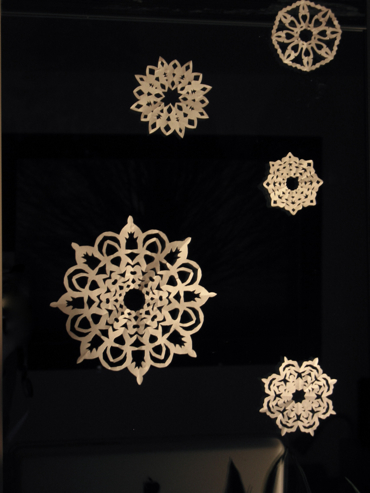

Before writing this post it occurred to me that I may not have the kind of readership that would be interested in a post like this. I’m of course aware that blog readership evolves on a mutual network, but I realised that almost all the blogs I read are on sustainability, climate change, transportation, and green lifestyles. So it became apparent, when I still had the desire to write about it, that I just love to write! While a month’s absence from blogging doesn’t appear to correlate, I think I just needed the equation time + something to get excited about = passion –> creativity. Well, it must have hit a backlog because now I have a couple on a waitlist here waiting to be written! (While I think of it, I should mention that Monday lunch blog posts fizzled in the last few weeks because I haven’t been working.) In this post I anticipate some of you will find issues and feelings to which you can relate. If you’ve grown up, moved out, and even moved back in, you’ll understand!
Continue reading The Urge to Purge / A History of Drawing »
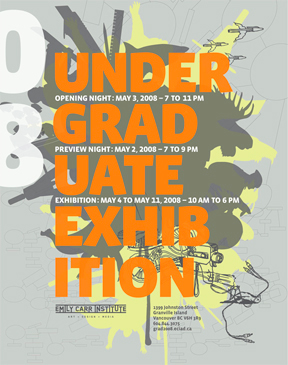
Saturday night I attended the ever-popular Emily Carr Undergraduate Exhibition, more commonly referred to as the “grad show” among my peers. There is some stellar work there, as always, and I strongly encourage anyone interested in art, communication design, industrial design, film or animation to get down there in the coming week and see the work of this year’s group of 350+ talents.
The show runs for a shorter period this year so you only have until this coming Sunday the 11th to see it for yourself! The show is open 10 am to 6pm at Emily Carr Institute, 1399/1400 Johnston St. on Granville Island. More info »
For myself and my class, today marks one year since our graduation and grad show… how time flies! The feeling walking to the show opening on that perfect sunny evening and the energy of the night itself has a nostalgic magic.
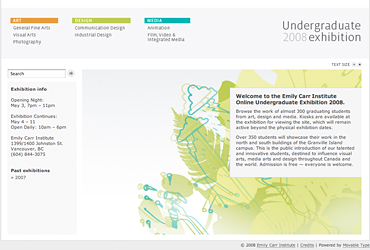
This year I helped put out the grad site again but with a much different set of roles. The student volunteers and coordinating faculty gave a tremendous effort; many thanks and congratulations go out to them for producing a fabulous grad 2008 website!
Note that many projects showing at the school are not on the website, and vice versa. This is particularly true of design projects which were not yet complete at the time of submission. So do visit the show, pick up a printed catalogue, and check out the website. Enjoy!



 I had a tea container I couldn’t recycle, so I repurposed it with a strip of cute paper.
I had a tea container I couldn’t recycle, so I repurposed it with a strip of cute paper.
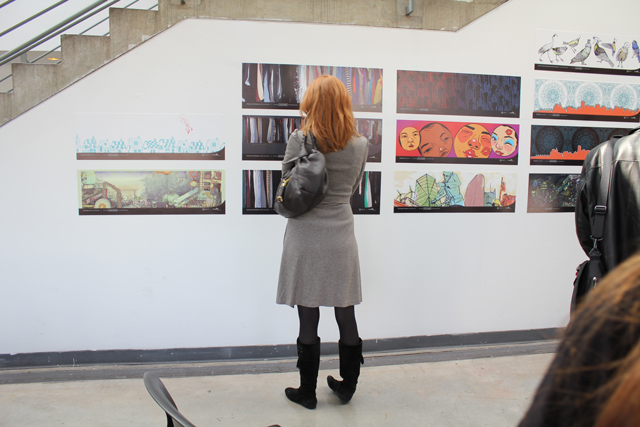 Photo from
Photo from 



